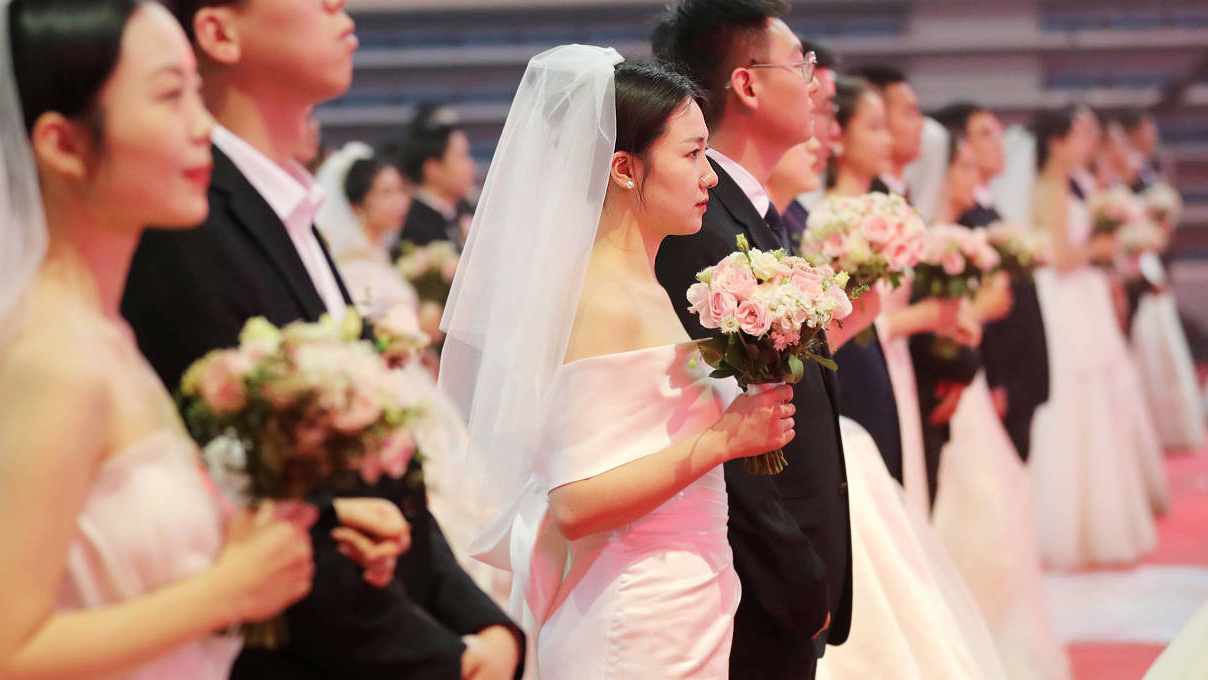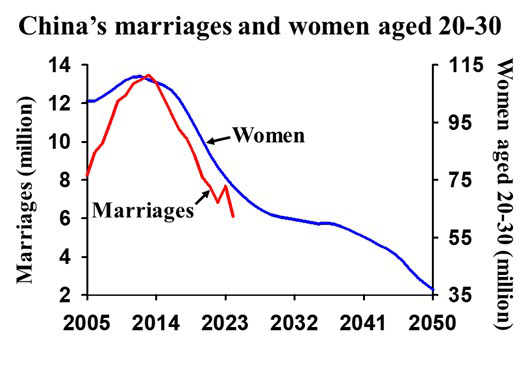
New marriages in China reportedly plummeted by one-fifth last year, implying that the official number of births will likely fall from 9.54 million in 2024 to 7.3- 7.8 million in 2025. Thus, while China represents 17.2% of the global population, it will account for less than 6% of births – comparable to Nigeria.
Moreover, China’s fertility rate in 2025 is expected to fall to 0.9 births per woman (2.1 is the standard replacement level), just half of what officials predicted in 2016. So alarming is this demographic reality that early this month Chinese Premier Li Qiang announced that the government will be rolling out new policies to boost the birth rate.
But the marriage crisis will greatly undermine these efforts. Marriages already plummeted from 13.47 million couples in 2013 to 6.11 million in 2024 – albeit with some deviation in 2020-24, owing to the zero-COVID policy. Likewise, the overall marriage rate fell from 9.9 per 1,000 people to 4.3 over the same period, compared to 5.4 in Taiwan and 6.1 in the United States (2023).
Why is this happening? Unfortunately for the Chinese leadership, there is no single cause. Salient factors include the steady decline in China’s childbearing-age population; changes in lifestyle; the lingering effects of the (now-discarded) one-child policy on attitudes toward marriage and childbearing; the persistent oversupply of men; and high youth unemployment.

According to China’s 2020 census, 61% of babies are born to women aged 20-30. But the number of women in this cohort dropped from 111 million in 2012 to 73 million in 2024, and is expected to decline further, to 37 million by 2050. Even if the fertility rate were to rise somewhat, births would continue to fall rapidly.
Decades of sex-selective abortion in China have led to a shortage of brides and a soaring “bride price” (the groom’s family must, at a minimum, purchase a new apartment). While the typical biological sex ratio at birth is between 102 and 106 males per 100 females, China’s 2000 census showed a sex ratio (in 0-4-year-olds) of 120 nationally, 133 in Jiangxi Province, and 197 in Wuxue City, Hubei Province. Yet despite this profound asymmetry, there are still many “leftover women,” because many parents with a daughter (almost always an only child) have prioritised her education and economic independence over marriage, and placed excessive expectations on aspiring sons-in-law. The proportion of unmarried women aged 25-29 in China soared from 9% in 2000 to 33% in 2020 and 43% in 2023 – and this trend continues to accelerate.
When China implemented its one-child policy in 1980, it not only raised the barriers to marriage but also made divorce easier, further exacerbating the crisis. The divorce rate soared from 0.3 per 1,000 people in 1980 to 3.4 in 2019. Hence, in 2021, China implemented a new civil code, following the example of the United Kingdom and France, to require a 30-day cooling-off period for divorce. But while this reduced the divorce rate to two per 1,000 people, it had rebounded to 2.6 by 2023 – much higher than Japan’s rate (1.5).
The reproductive window for Chinese men and women is very short. A woman typically has 12% of her eggs left by age 30, and only 3% by 40. The risk of miscarriage increases from 10% for women under 30 to 20% at 35, 33-40% at 40, and 57-80% at 45. The chance of conceiving a child with Down syndrome increases with the mother’s age, rising from one in 2,000 at age 20 to one in 350 at age 35, and up to one in 30 at age 45. As the age of marriage is postponed, interest in raising children also declines.
That is why about two-thirds of babies worldwide are born to women aged 30 and under. In 2021, the mean age of mothers at first birth was 27 in the United States, 27 in Mexico, and only 21 in India. By comparison, the mean age at first birth for Chinese women has risen from 25 in 2000 to 28 in 2020, with an accelerating increase in recent years. In Shanghai, it increased from 30 in 2019 to 32 in 2024. Worse, the overall infertility rate in China has increased from 1-2% in the 1970s to 18% in 2020. More and more people are becoming infertile after marriage or after having their first child.
Traditionally Confucian-influenced regions have the lowest fertility rates in the world, partly because their overemphasis on education translates into an underemphasis on marriage and childbearing. As a result, such regions have a higher proportion of unmarried people overall, and the historical data suggest that it will be virtually impossible to boost their fertility rate even to 1.5 if the mean age of mothers at first birth exceeds 28.
Internationally, the legal minimum age for marriage is usually between 16 and 18. But in China, it was raised to 22 for men and 20 for women in 1980. People have grown so accustomed to marrying and having children later that lowering the age to 18 would do nothing now to boost the fertility rate.
The widespread postponement of marriage and childbearing, like the soaring proportion of unmarried people, is largely attributable to the government’s policies in pursuit of a talent dividend and “new quality productive forces.” These policies have led to an increase in undergraduate and postgraduate enrollment, from 2.21 million and 129,000, respectively, in 2000, to 10.69 million (much more than this year’s births) and 1.36 million in 2024. Meanwhile, China’s tertiary education enrollment rate has surpassed Japan’s, implying that its fertility rate will struggle to stabilise at Japan’s current level of 1.15.
Can China’s government resolve the contradiction between its economic ambitions and its demographic reality? Judging by its past efforts, no one should bet on it.
*Yi Fuxian, a senior scientist in obstetrics and gynecology at the University of Wisconsin-Madison, is the author of Big Country with an Empty Nest. Copyright 2025 Project Syndicate, here with permission.
6 Comments
For so long Chinese women would only marry a guy, if he owned a property, now they have all bankrupted themselves buying property, perhaps they will only marry a man who does not own property.
What a mess.
An almost impossible problem to solve. It seems you need a population that is highly religious or else is mostly rural and isolated and once that changes there is no going back. Perhaps significant state provided financial assistance could work however there have been attempts at this in the past that haven't been particularly successful.
In an age of information there is greater awareness and when you think about bringing children into the world it raises questions about consent and suffering. Modern humans are aware that children are not extensions of themselves, they are at most, just repositories for the replication of selfish genes. Even then, not exact replicas but mixtures. Is it really something that should be done?
Population decline is not a problem.
Unless you need a fireman, police man, nurse, welfare or pension you will be fine. I'd add soldier to that but we seem to be winging that since the last world war.
Great article, and a telling reminder about how poorly conceived (pardon the pun) policies can have longer-term objective effects. Interesting also to look at fertility rates in the US, where postponing first child till 30 is becoming the norm - especially for those with higher/educations/incomes.
The social impacts are horrendous. We see a concentration of wealth amongst those with both intergenerational wealth and contemporary advantage. The obverse is equally evident.
The social impacts are horrendous. We see a concentration of wealth amongst those with both intergenerational wealth and contemporary advantage. The obverse is equally evident.
Lowering birth rate, lowering rates of homeownership, decreased social cohesion, increased crime, and the slow implosion of the health sector and pension system. All attributable, at least in part, to wealth inequality, and the assumption of bigger families each generation to kick the costs through to.

We welcome your comments below. If you are not already registered, please register to comment.
Remember we welcome robust, respectful and insightful debate. We don't welcome abusive or defamatory comments and will de-register those repeatedly making such comments. Our current comment policy is here.